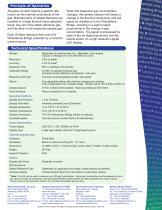
Catalog excerpts

542 Programmable Gas AnalyzerCapable of measuring almost any combination of gases; hydrogen, helium, oxygen, carbon dioxide, methane, carbon monoxide, argon, nitrogen and many others. ,e/ fi/a 0r)An y Ufa w>o n, ^ct Blank( Anai,. Food Packaging Gases Features & Benefits • Programmable for different gases • Built-in linearization • Fast response • Excellent stability • Built-in alarms and analog outputs Diagnostics Insensitive to sample flow Computer communications Autoranging electronics Built-in auto-calibration The 542 is a versatile, programmable gas analyzer, based on the principles of thermal conductivity, capable of measuring almost any combination of gases. The instrument is especially suitable for measurements of mixtures containing hydrogen or helium. With the use of sensitive floating circuits, the thermal conductivity analyzer can detect gases down to parts per million levels and up to full concentration. The analyzer is pre-programmed for a wide range of sample and reference gases, easily selectable from the simple front panel menu. Calibration settings, for each combination of gases used, are stored in an internal memory and are recalled automatically every time a particular gas mix is required. This enables quick and easy switching between gas combinations. Sophisticated microprocessor electronics enable the fastest possible response time, excellent stability and flexibility. Sample pressure and flow are internally controlled allowing connection to a wide range of pressurised samples. Automatic calibration is included as standard, when the instrument can be set to perform a zero and span calibration at timed intervals.
Open the catalog to page 1
All gases conduct heat at a specific rate, known as the thermal conductivity of the gas. Matched pairs of heated filaments are installed in a large thermal mass detection block, one set in the stable reference gas and the other in the measured sample gas. Each of these detectors form part of a Wheatstone Bridge powered by a constant current source. When the measured gas concentration changes, the sample detector will detect a change in the thermal conductivity and will cause an imbalance in the Wheatstone Bridge, resulting in a signal output proportional to the change in gas concentration....
Open the catalog to page 2All Systech Illinois catalogs and technical brochures
-
BT Integra-Pack
2 Pages
-
OxySense® Model 8101e
2 Pages
-
Gaspace Advance Micro
3 Pages
-
GS Waterproof
2 Pages
-
AquaSense Model TM7100
2 Pages
-
OxySense® Model 8100e
2 Pages
-
MM300 Moisture Transducer
2 Pages
-
Lyssy L80-5000
2 Pages
-
GS6000 Headspace Analyser
3 Pages
-
MM400 Moisture analyser
3 Pages
-
MM500 Moisture Analyser
3 Pages
-
ZR800 Oxygen analyser
3 Pages



































